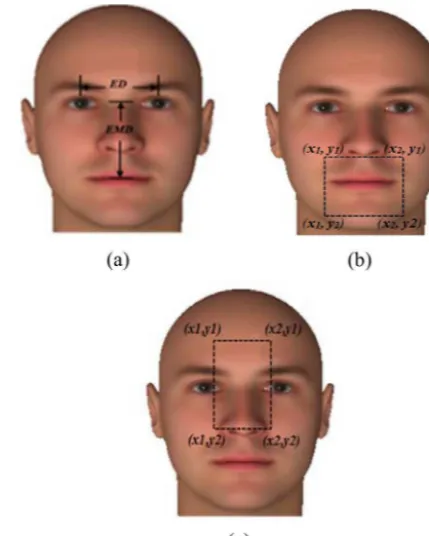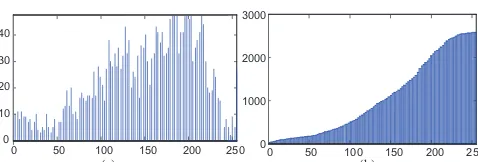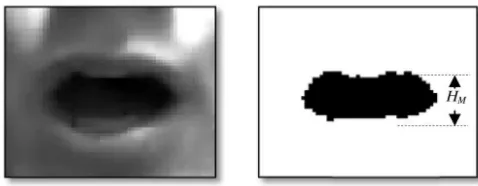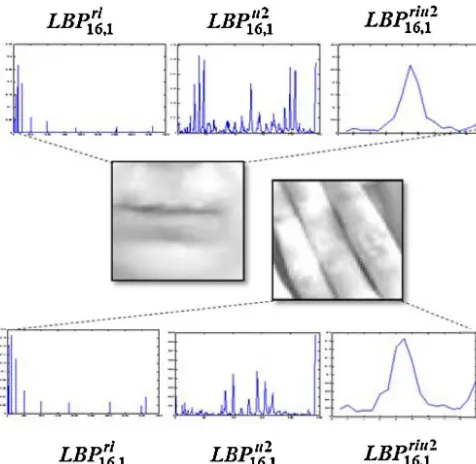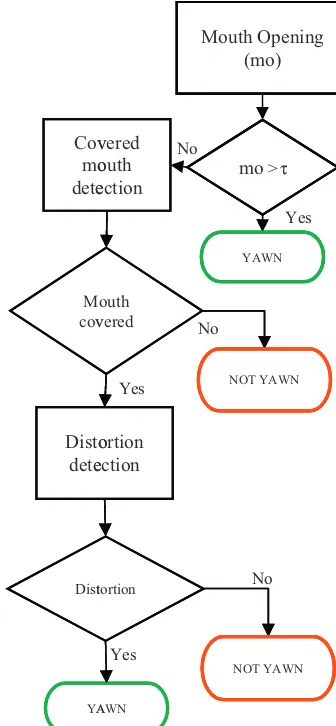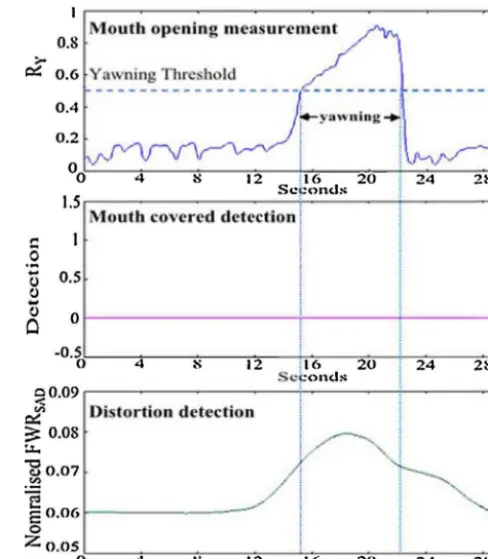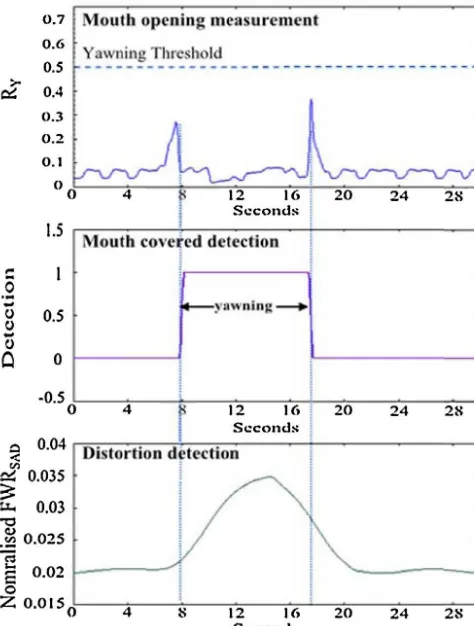ContentslistsavailableatScienceDirect
Biomedical
Signal
Processing
and
Control
j ou rn a l h o m e pa g e :w w w . e l s e v i e r . c o m / l o c a t e / b s p c
Yawn
analysis
with
mouth
occlusion
detection
Masrullizam
Mat
Ibrahim,
John
J.
Soraghan,
Lykourgos
Petropoulakis,
Gaetano
Di
Caterina
∗DepartmentofElectronicandElectricalEngineering,UniversityofStrathclyde,204GeorgeStreet,G11XWGlasgow,UnitedKingdom
a
r
t
i
c
l
e
i
n
f
o
Articlehistory:
Received11August2014 Receivedinrevisedform 10December2014 Accepted9February2015
a
b
s
t
r
a
c
t
Oneofthemostcommonsignsoftirednessorfatigueisyawning.Naturally,identificationoffatigued individualswouldbehelpedifyawningisdetected.Existingtechniquesforyawndetectionarecentredon measuringthemouthopening.Thisapproach,however,mayfailifthemouthisoccludedbythehand,asit isfrequentlythecase.Theworkpresentedinthispaperfocusesonatechniquetodetectyawningwhilst alsoallowingforcasesofocclusion.Formeasuringthemouthopening,anewtechniquewhichapplies adaptivecolourregionisintroduced.Fordetectingyawningwhilstthemouthisoccluded,localbinary pattern(LBP)featuresareusedtoalsoidentifyfacialdistortionsduringyawning.Inthisresearch,the StrathclydeFacialFatigue(SFF)databasewhichcontainsgenuinevideofootageoffatiguedindividualsis usedfortraining,testingandevaluationofthesystem.
©2015ElsevierLtd.Allrightsreserved.
1. Introduction
Fatigueisusuallyperceivedasthefeelingoftirednessor drowsi-ness.Inaworkrelatedcontext,fatigueisastateofmentaland/or physicalexhaustionthatreducestheabilitytoperformworksafely andeffectively.Fatiguecanresultduetoanumberoffactors includ-inginadequaterest,excessivephysicalor mentalactivity,sleep patterndisturbances,orexcessivestress.Therearemany condi-tionswhichcanaffectindividualsandwhichareconsidereddirectly relatedtofatiguesuchasvisualimpairment, reducedhand–eye coordination,lowmotivation,poorconcentration,slowreflexes, sluggishresponse orinabilitytoconcentrate. Fatigueis consid-eredasthelargestcontributor toroadaccidents,leadingtoloss of lives. Data for 2010 from the Department of Transport, UK
[1],points to 1850people killed,and 22,660seriouslyinjured, withfatiguecontributingto20%tothetotalnumberofaccidents
[2]. US National Highway Traffic Safety estimates suggest that approximately100,000accidentseachyeararecausedbyfatigue
[3].
Fatigueisidentifiablefromhumanphysiologysuchaseyeand mouth observations, brainactivity, and by using electrocardio-grams(ECG) measuring,for example,heartratevariability. The physical activities and human behaviour may also be used to identifyfatigue[4–6].Inthis paperyawning, indicatingfatigue, is detectedand analysed from video sequences. Yawning is an
∗Correspondingauthor.Tel.:+44(0)1415484458.
E-mailaddress:gaetano.di-caterina@strath.ac.uk (G.DiCaterina).
involuntary action where the mouth opens wide and, for this reason,yawningdetectionresearchfocusesonmeasuringand clas-sifyingthis mouth opening.Frequently, however,this approach is thwartedbythecommonhumanreaction tohand-coverthe mouthduringyawning.Inthispaper,weintroduceanewapproach
todetectyawning bycombiningmouth openingmeasurements
witha facialdistortion (wrinkles)detectionmethod.For mouth openingmeasurementsanewadaptivethresholdforsegmenting themouthregionisintroduced.Foryawningdetectionwiththe mouthcovered,localbinarypatterns(LBP)featuresandalearning machineclassifierareemployed.Inordertodetectthewrinkles, theedgedetectorSobeloperator[30]isused.Differentlyfrom[32], wherethemouthcovereddetectiontechniqueisappliedtostatic imagesonly,theyawnanalysisapproachproposedinthispaper describesacompletesystemforyawndetectioninvideosequences. Inthisresearch,genuineyawningfatiguevideodataisusedfor training,testingandevaluation.ThedataisfromtheStrathclyde FacialFatigue(SFF)videodatabase,whichwasexplicitlycreated toaid this research,and which contains series of facial videos of sleep deprived fatigued individuals. The, ethically approved, sleepdeprivationexperimentswereconductedattheUniversity ofStrathclyde,withtheaidoftwentyvolunteersundercontrolled conditions.Eachofthe20volunteerswassleepdeprivedfor peri-odsof0,3,5and8honseparateoccasions.Duringeachsessionthe participants’faceswererecordedwhiletheywerecarryingouta seriesofcognitivetasks.
Theremainderofthispaperisorganisedasfollows.Section2
discussestherelatedworkofthisresearch,whileSection3explains theSFF database.Section4 discusses theoverall system,while
http://dx.doi.org/10.1016/j.bspc.2015.02.006
of the mouth opening [7–9]. The algorithms used must there-forebeabletodifferentiatebetweennormalmouthopeningand yawning.Yawndetectioncanbegenerallycategorisedintothree approaches;featurebased,appearancebased,andmodelbased.In thefeaturebasedmethod,themouthopeningcanbemeasured byapplying severalfeatures suchascolour, edges andtexture, whichareabletodescribetheactivitiesofthemouth.Commonly, therearetwoapproachestomeasurethemouthopening,mainly bytrackingthelipsmovementandbyquantifyingthewidthof themouth.Sincethemouthisthewiderfacialcomponent,colour isoneof theprominentfeatures usedtodistinguishthemouth region.Yao et al. [10] transfer RGB colour spaceto LaB colour spaceinordertousethe‘a’component,whichisfoundas accept-ableforsegmentingthelips. Thelipsrepresenttheboundaryof themouthopeningthat istobe measured.YCbCr colourspace waschosen by Omidyeganeh [11] for their yawning detection. In that work,the claim is that colour spaceis able toindicate themouthopeningarea, whichis thedarkestcolour region,by setting a certain threshold. Yawning is detected by computing theratioofthehorizontalandverticalintensityprojectionofthe mouthregion.Themouthopeningisdetectedasyawnwhenthis ratiois aboveasetthreshold. Implementationusingthecolour propertiesiseasybut,tomakethealgorithmrobust,several chal-lengesmustbeaddressed.Thelipscolourisdifferentforeveryone, andduetothedifferentlightingconditionsitisnecessarytoensure thatthethresholdvalueisadaptedtothechanges.
Edgesareanothermouthfeatureabletorepresenttheshape ofthemouthopening.Aliouaetal.[12]extractedtheedgesfrom thedifferencesbetweenthelipsregionandthedarkestregionof themouth.Thewidthofthemouthis measuredinconsecutive frames, and yawn is detectedwhen themouth is continuously openingwidelymorethanasetnumberoftimes.Whenusingthe edgestodetermineyawn,thechallengeisthatthechangesofthe edgesareproportionaltotheilluminationchanges,makingit dif-ficulttosettheparameterofanedgedetector.Inordertolocate accuratelythemouthboundary,theactivecontouralgorithmcan beusedasimplementedin[8].However,thecomputationalcost ofthisapproachisveryhigh.Themouthcornershavealsobeen employedbyXiaoetal.[9]todetectyawn.Themouthcornerscan
bereferencepointsinordertotrackthemouthregion.Yawning isclassifiedbasedonthechangeofthetextureinthecornerof themouthwhilethemouthisopenedwidely.Moreover,asinthe caseimplementedformeasuringeyeactivities,Jiménez-Pintoetal.
[13]havedetectedtheyawnbaseduponthesalientpointsinthe mouthregion.ThesesalientpointsintroducedbyShiandTomasi
[14]areabletodescribethemotionofthelipsmovement,andyawn isdeterminedbyexaminingthemotioninthemouthregion.In
[7,11]yawnisdetectedbasedonahorizontalprofileprojection. Theheightofthemouthopeninginprofileprojectionrepresents themouthyawn.However,thisapproachisinefficientforbeard andmoustachebearingindividuals.
Inappearancebasedmethod,statisticallearningmachine algo-rithmsareappliedanddistinctivefeaturesneedtobeextractedin ordertotrainthealgorithms.Lirongetal.[15]combinedHaar-like featuresandvariancevalueinordertotraintheirsystemtoclassify thelipsusingsupportvectormachine(SVM).Withtheadditional integrationofaKalmanfiltertheiralgorithmisalsoabletotrack thelipregion.Linglingetal.[16]alsoappliedHaar-likefeaturesto
yawnclassificationinthreestates:mouthclosed,normalopen,and wideopen.Themouthregionfeaturesareextractedbasedonthe RGBcolourproperties.Forthisapproachahugenumberofdatasets forimagesisrequiredinordertoobtainadequateresults.
Themodelbasedapproachrequiresthatthemouthorlipsare modelledfirst.Anactiveshapemodel(ASM)forinstance,requires asetoftrainingimagesand,ineveryimage,theimportantpoints thatrepresentthestructureofthemouthneedtobemarked.Then, themarkedsetofimagesisusedfortraining usingastatistical algorithmtoestablishtheshapemodel.
García et al.[18] and Anumaset al. [19] train thestructure usingASM, and theyawn ismeasuredbased onthelips open-ing.Hachisukaetal.[20]employactiveappearancemodel(AAM),
whichannotateseachessentialfacialpoint.Foryawningdetection threepointsaredefinedtorepresenttheopeningofthemouth.In thisapproachalotofimagesarerequiredsinceeverypersonhas differentfacialstructure.
3. StrathclydeFacialFatigue(SFF)database
TheStrathclydeFacialFatiguedatabasewasdevelopedinorder toobtaingenuinefacialsignsoffatigue.Mostofthefatiguerelated researchershaveusedtheirowndatasetsforassessingtheir devel-opedsystem.Forexample,Vuraletal.[21]developedtheirfatigue databasebyusingvideofootagefromasimulateddriving environ-ment.Theparticipantshadtodriveforover3handtheirfaceswere recordedduringthattime.Fanetal.[22]recruitedforty partici-pantsandrecordedtheirfacesforseveralhoursinordertoobtain facialsignsoffatigue.Someresearchersonlytesttheiralgorithms based on video footage of persons who pretend to experience fatiguesymptoms.Forexample,researchersin[8,11,12]detected yawnbasedonthewidthofthemouthopeningandthealgorithms werenottestedonsubjectsexperiencingnaturalyawning.TheSFF databaseprovidesagenuinemediumoffacialfatiguevideofootage fromsleepdeprivationexperimentswhichinvolvedtwenty partic-ipants.
Thesleepdeprivedvolunteerswere10maleand10femalewith agesrangingbetween20to40yearsold.Eachvolunteerhadto per-formaseriesofcognitivetasksduringfourseparateexperimental sessions.Priortoeachsession,theparticipantsweresleepdeprived for0h(nosleepdeprivation),3,5and8hundercontrolled condi-tions.Thecognitivetasksweredesignedtotest(a)simpleattention, (b)sustainedattentionand(c)theworkingmemoryofthe partici-pants.Thesecognitivetasksareassociatedwithsensitivitytosleep lossandaredesignedtoacceleratefatiguesigns.Fig.1showssome examplesofvideofootageintheSFFdatabase.
4. Systemoverview
Ablockdiagramofthenewyawnanalysissystemisshownin
Fig.2.Thesystembeginswithaninitialisationoperationcarriedout inthefirstframeofthevideo.Thisconsistsoffaceacquisitionand regioninitialisationalgorithms.Duringfaceacquisition,theface, eyeandmouthdetectionalgorithmsareperformedsequentially beforearegionofinterestinitialisationalgorithmisexecuted.
M.M.Ibrahimetal./BiomedicalSignalProcessingandControl18(2015)360–369
Fig.1. ExampleimagesfromvideofootageSFF.
Fa
Eye
Mouth Detection Face Detection ace acquisition
Regions Interest Initialisation
Yawn analysis operations Detection
Fig.2.Yawnanalysissystemoverview.
tobetrackedinallthefollowingframes.TheFMRregionisused inmeasuringthemouthopeningandtodetectwhenthemouth iscovered,andFDRisusedinmeasuringthedistortionsduring yawning.
4.1. Regionofinterestevaluation
Asis indicatedin[32] afacial regionof interestneedstobe establishedfirst.Fig.3depictsafaceacquisitionoperationwhere theeyesandmoutharesequentiallydetectedusingaViolaJones technique[23,24].Trainingisperformedthroughacascade clas-sifierappliedtoeverysub-window intheinputimagein order toincreasedetectionperformanceandreducecomputationtime. TheSFF video footageprovided thelargenumber of face, eyes and mouthdata neededtotrain the Haar-likefeatures [25,26]. Inthepresentmethod,thefaceregionisfirstdetectedandthen, theeyesandmouthareasareidentifiedwithinit.Theacquisition ofthedistinctive distances betweenthesefacialcomponents is effectedthroughanthropometricmeasurements,thusaccounting forhumanfacialvariability.Thisinformationisthenusedinthe formationofthetwofollowingregionsofinterest.
4.1.1. Focusedmouthregion(FMR)
Thisisformedbaseduponthedetectedlocationsoftheeyesand mouth.Thedistancebetweenthecentreoftheeyes(ED),andthe distancebetweenthecentreofmouthandthemid-pointbetween theeyes(EMD)areobtained(Fig.3(a)).Theratioofthesedistances
REMisthencomputedas:
REM= ED
EMD (1)
Fig.3. (a)Anthropometricmeasurement;(b)focusedmouthregion(FMR);(c) focuseddistortionregion(FDR).
FromthisinformationthecoordinatesoftheFMR(Fig.3(b))are empiricallydefinedas:
x1y1
=
xR
yR+0.75EMD
(2)
x2y2
=
xL
yL+0.75EMD+0.8ED
(3)
where(xR,yR)and(xL,yL)arethecentrepointsoftherighteyeiris andlefteyeiris,respectively.TheFMRdependsonthelocationand distanceoftheeyes.Whenthefacemovesforwardtheeye dis-tanceincreasesandsodoestheFMR.Conversely,theFMRreduces followingabackwardmove.
4.1.2. Focuseddistortionregion(FDR)
Thefocuseddistortionregion(FDR)isaregioninthefacewhere changesoffacialdistortionoccur.Theregion,whichismostlikely toundergodistortionsduringyawning, wasidentifiedbased on conductedexperimentsusingtheSFFdatabase.Thecoordinatesof theFDR(Fig.3(c)),areempiricallydefinedas:
x1y1
=
xR
yR−0.75EMD
(4)
x2y2
=
xL
yL+0.75EMD
(5)
Thethresholdvalues0.75and0.8usedinEqs.(2)–(5)arebased onobservationtests,undertakenontheSFFdatabase.
4.2. Yawnanalysisoperations
Fig.4. AlineartransformthatremapsintensitylevelinputimageinbetweenG′ min andG′
max.
0 0 10 20 30 40
(a)
50 100 150 200 250 00 50
1000 2000 3000
(b)
100 150 200 250
Fig.5.(a)Enhancedimagehistogram;(b)cumulativehistogram.
openingmeasurement, coveredmouthdetection,and distortion detection.
4.2.1. Mouthopeningmeasurement
Yawningisaninvoluntaryactionthatcausesapersontoopen themouth widely and breathe in. The technique in this paper detectsyawningbaseduponthewidestareaofthedarkestregion betweenthelips.Aspreviouslydiscussedwhenappliedtechniques arebasedonintensitiesandcolourvalues,thechallengeistoobtain anaccuratethresholdvaluewhichwilladapttomulti-skinandlips colouration,aswellastodifferentlightingconditions.Theproposed algorithmappliesanewadaptivethresholdinordertomeetthis challenge.
Theadaptivethresholdvalueiscalculatedduringthe initialisa-tionoperationaftertheFMRisformed.Duetothedependenceof themethodontheintensityvalueoftheregion,itisnecessaryto improvethefaceimageinordertocontrastenhancethedarkest andthebrightestfacialregions.Theenhancementisimplemented bytransformingthehistogramoftheimagetospreadthelevelof colourvaluesevenlybutwithoutchangingtheshapeoftheinput histogram.Thisiscomputedusingthefollowing transformation
[27]:
g′(x,y)=G ′
max−G′
min
Gmax−Gmin[g(x,y)−Gmin]+G
′
min (6)
ThelineartransformationillustratedinFig.4stretchesthe his-togramoftheinputimageintothedesiredoutputintensitylevel ofthehistogrambetweenG′
minandG′max,whereGminandGmaxare
theminimumandmaximuminputimageintensities,respectively. FromthisenhancedhistogramillustratedinFig.5(a),the cumu-lativehistogramHiiscalculatedasinEq.(7),thusgeneratingthe
Fig.6. Focusedmouthregion(FMR).
Fig.7.FMRsegmentationusingadaptivethreshold.
totalnumberofindexpixelsinthehistogrambinsbetween0and 255asillustratedinFig.5(b).
Hi= i
j=1
hj (7)
Consequently,theinitialadaptivethresholdiscalculatedby ref-erencetothedarkestareaasshowninFig.6.Onaverage,thedarkest areaconstitutesapproximately5%,orless,oftheentireobtained regionofinterest.Basedonthispercentage,thedarkestareainthe histogramissituatedbetween0andXintensitylevels.The inten-sityvalueXcanbeobtainedbyselectingthefirst5%ofthetotal numberofpixelscontainedintheenhancedhistogram(Fig.5(a)) andreadingthecorrespondingright-mostintensityvaluefromthe
x-axis.
Then,theadaptivethresholdTavalueiscalculatedasfollows:
Ta=
X−Pmin
Pmax−Pmin (8)
wherePmaxandPminarethemaximumandminimumpixelvalues,
respectively.
AftertheadaptivethresholdTa iscomputed,theFMRis seg-mentedandthemouthlengthLMisobtainedasillustratedinFig.7. ThelengthofLMmustbewithintherangeindicatedinthefollowing equation:
0.7ED<LM<0.9ED (9)
IfLMisoutsidethisrange,thevalueTaisincreasedordecreased accordingly,instepsof0.001.Thenthesegmentationprocessis repeateduntilthevalueofLMiswithinrangeasinEq.(9).
Theadaptivethresholdisappliedtothenextsequenceofframes forsegmentingthedarkestregionbetweenthelips.In orderto determinetheyawning,theheightofthemouthHM,basedonthe darkestregioninFMR,ismeasuredasshowninFig.8.Then,the YawnRatio(RY)oftheheightHMovertheheightofFMRiscomputed asfollows:
RY =
HM
FMRheight (10)
M.M.Ibrahimetal./BiomedicalSignalProcessingandControl18(2015)360–369
Fig.8. Themeasurementofhighofmouthopening.
Fig.9.(a)Uncoveredmouth;(b)coveredmouth.
Fig.10.ExampleofthebasicLBPoperator.
4.2.2. Coveredmouthdetection
Itisnotunusualtooccludethemouthwiththehandduring yawning.ThismeansthatinformationfromSection4.2.1canno longerbeusedtodetectyawning.Theapproachfirstintroducedin
[32]onstillimagescanalsobeusedinvideosequencefootage.The approachinvolvesthattheFMRisexaminedtodeterminewhether theregioniscoveredornot.Fig.9displaysimagesofFMR(a)not coveredand(b)covered.Fromtheseimagesthedifferenttexture oftheFMRregionsisclearlyobviousinthetwocases.Inorderto differentiatebetweenthesetwocases,localbinarypatterns(LBP) areused toextractthe FMRtexturepattern. LBPfeatures have beenprovenhighlyaccuratedescriptorsoftexture,arerobustto themonotonicgrayscalechanges,aswellassimpletoimplement computationally[28].
Localbinarypatterns(LBP)wasoriginallyappliedontexture analysistoindicatethediscriminativefeaturesoftexture.With ref-erencetoFig.10,thebasicLBPcodeofthecentralpixelisobtained bysubtractingitsvaluefromeachofitsneighboursand,ifanegative numberisobtained,itissubstitutedwitha0,elseitisa1.
TheLBPoperatorislimitedsinceitrepresentsasmallscale fea-turestructurewhichmaybeunabletocapturelargescaledominant features.Inordertodealwiththedifferentscaleoftexture,Ojalaet al.[29]presentedanextendedLBPoperatorwheretheradiusand samplingpointsareincreased.Fig.11showstheextendedoperator
Fig.11.ExampleofextendedLBPoperator.(a)(8,1);(b)(16,2)and(c)(24,3)
neigh-bourhoods.
wherethenotation(P,R)representsaneighbourhoodofPsampling pointsonacircleofradiusR.
TheLBPresultcanbeformulatedindecimalformas:
LBPP,R(xc,yc)=
P−1
P=0
s(iP−ic) 2P (11)
whereic andiPdenotegraylevelvaluesofthecentralpixeland
Prepresentsurroundingpixelsinthecircleneighbourhoodwith radiusR.Functions(x)isdefinedas:
s(x)=
1, if x≥ 0
0, if x<0 (12)
TheLBPoperator,as formulatedinEq. (11),hasa rotational effect.Hence,iftheimageisrotated,then,thesurroundingpixelsin eachneighbourhoodaremovingaccordinglyalongtheperimeter ofthecircle.InordertoremovethiseffectOjalaetal.[29]proposed arotationalinvariant(ri)LBPasfollows:
LBPri P,R=
minRORLBPP,R,i
i=0, 1,..., P−1 (13)
whereROR(x,i)performsacircularbitwiserightshiftontheP-bit numberxwithitime.ALBPuniformpattern(u2),LBPu(P,R2 )wasalso
proposed.TheLBPiscalleduniformwhenitcontainsamaximum oftwobitwisetransitionsfrom0to1orviceversa.Forexample, 1111111(0transition)and00111100(2transitions)areboth uni-form,but100110001(4transitions)and01010011(6transitions) arenotuniform.AnotherLBPoperator,whichisacombinationof arotationalinvariantpatternwithauniformpattern,isLBPriu2
(P,R).
Thisoperator isobtainedbysimplycountingthe1’sinuniform patterncodes.Allnon-uniformpatternsareplacedinasinglebin. AnexampleofanLBPhistogramofthethreetypesofLBPoperators forcoveredanduncoveredmouthregionisshowninFig.12.
AclassifierthenusestheLBPfeaturestodetectmouthcovering, asexplainedinSection6.2.
4.2.3. Distortionsdetection
Yawning cannot be concluded solely on the detection of a coveredmouthregion.Itispossiblethatthemouthiscovered acci-dentallyorevenintentionallyforreasonsunrelatedtoyawning.To minimisethepossibilityoffalseyawndetection,themetricof dis-tortionsinaspecificregionoftheface,mostlikelytodistortwhile yawning,isalsoused[32].Thisregionisidentifiedbasedon obser-vationsandtheexperimentsconductedusingthevideo footage fromtheSFFdatabase.
Theregionmostaffectedbydistortionduringyawningisthe focuseddistortionregion(FDR)(Section4.1.2).FromFig.13bandc itisobviousthattherearesignificantvisualdifferencesintheFDR areabetweennormalconditionsandduringyawning.
ToevaluatethechangesoccurringinFDR,edgedetectionisused toidentifythedistortions.Hereanyedge detectorcanbeused. However,basedonexperimentscarriedout,theSobeloperator[30]
Fig.12.LBPhistogramfornotcoveredmouthandcoveredmouthregions.
Fig.13.(a)Focuseddistortionregion(FDR);(b)normalconditioninFDR;(c) yawn-inginFDR.
intensitygradientateachpointintheregionofinterest.Then,it providesthedirectionofthelargestpossibleincreasefromlightto darkandtherateofchangeinthehorizontalandverticaldirections. TheSobeloperatorrepresentsapartialderivativeoff(x,y)andof thecentralpointofa3×3areaofpixels.Thegradientsforthe hor-izontalGxandverticalGydirectionsfortheregionofinterestare thencomputedas[31]:
Gx=
f(x+1, y−1)+2f(x+1, y)+f(x+1, y+1)−
f(x−1, y−1)+2f(x−1, y)+f(x−1, y−1) (14)Gy=
f(x−1, y+1)+2f(x, y+1)+f(x+1, y+1)−
f(x−1, y−1)+2f(x, y−1)+f(x+1, y−1) (15)TheFDRdistortionsaredetectedbasedonthegradientsinboth directionsandtheresultsareshowninFig.14.Thenumberofedges detectedundernormalconditions,asillustratedinFig.14(a),is sig-nificantlydifferentcomparedtoyawning(Fig.14(b)).Inorderto identifythedistortionintheFDRduringyawning,thesumFDRSAD
oftheabsolutevaluesobtainedinEq.(16)isusedtocomputethe numberofwrinklesintheregion.ThenormalisedFDRSADis calcu-latedinEq.(17)whereWandHdenotethewidthandheightofthe FDR,respectively.
Fig.14. FDRwithinputimageandedgesdetectedimage.(a)Normal;(b)yawn.
Fig.15.PlotofnormalisedFDRSADvaluesduringyawning.
Duringyawning,thenumbersofthedetectededgesincreaseas showninFig.15.
FDRSAD =
i,j
I1(i,j)−I2(x+i,y+j) (16)
Normalised FDRSAD= FDRSAD
255×W×H (17)
5. Yawnanalysis
Ingeneral,theactionofyawningcanbecategorisedintothree situations:(a)mouthnot-coveredandwideopen,(b)mouthwide open for a short time before it gets covered and, (c) mouth totallycoveredwithinvisiblemouthopening.Thesesituationsare based ontheobservations madefrom thevideo footageof the SFFdatabase.Ayawnanalysisalgorithm, asdepictedinFig.16, wasthereforedevelopedtodealwiththesecasesbyintroducing theaforementionedprocedures,i.e.mouthopeningmeasurement, mouthcovereddetectionanddistortionsdetection.
Inthisalgorithm,thestatusofmouthopening,mouthcovered, anddistortionsareexaminedperiodically.Thechosentimeframe formeasurements,basedonobservationsfromtheSFFdatabase, is30s—atimeintervalreachedbyexaminingtheSFFvideodata. Thisassumesthatyawningdoesnotoccurtwicewithinthistime period.
The algorithm starts byfirst examining themouth opening. Yawningisidentifiedthroughthemouthopeningforlongerthana fixedinterval,usuallybetween3and5s.Ifthisshowsnoyawning, thenthemouthcovereddetectionistriggered.Thestatusof distor-tionsinFDRisonlyexaminedwhenmouthcoveringisdetected.
M.M.Ibrahimetal./BiomedicalSignalProcessingandControl18(2015)360–369
Cov
mo
dete
M cov
Disto
dete
Dist
YA
Yes No
Yes No
vered
outh
ection
outh vered
ortion
ection
tortion
AWN
No Yes
Mouth
Openin
g
(mo)
mo
>YAWN
NOT YAWN
NOT YAWN
Fig.16.Yawnanalysisalgorithm.
6. Experimentalresults
Theperformanceof thedevelopedalgorithms wastested by usingthefullSFFvideofootage.Theresultspresentedherewerethe outcomeofsubstantialreal-timeexperimentationusingthevideo sequencesfromthewholeofthedatabase.
6.1. Mouthopeningmeasurement
Themouthopeningmeasurementalgorithmsaretestedusing theSFFdatabase.Inordertoevaluatetheaccuracyofthemouth openingsegmentationusingtheproposedadaptivethreshold,the actualinput image is compared withthe segmented region of mouthopening.Fig.17showsexamplesofmouthopeningimages pairedwiththeoutputimageofmouthopeningsegmentation.A totalof145mouthopeningimagesundervaryinglighting condi-tionswereusedfortesting.Fromthesetests,itwasshownthatthe algorithmwasabletosegmentthedarkestregionbetweenthelips asrequiredfordetectingyawning.
AsdiscussedinSection4,yawningisdeterminedbymeasuring theheightofthesegmentedregionofthemouthopening.
Inordertoobtaintheapplicablethresholdvaluethatrepresents yawning,25oftherealyawningscenesfromtheSFFdatabasewere used.Fromtheyawningscenesitwasfoundthattheminimum valueofRYwhichdenotesyawningis0.5.Thisratiovalueisapplied inmouthopeningmeasurementsduringyawnanalysis.
Fig.17.Mouthopeningsegmentationimages.
6.2. Mouthcovereddetection
Inordertodetectthecoveredmouth,theFMRisexaminedin everyvideoframe.TheLBPfeaturesareextractedfromtheregion, andthelearningmachinealgorithmdecidesthestatus.The clas-sifierstested,todeterminetheirsuitabilityforuseintheanalysis algorithm,comprisedsupportvectormachines(SVM)andneural networks(NN).
A total of 500covered mouth images and 100non covered mouthimagesofsize50×55pixelhavebeenusedtotraintheNN andSVMclassifiers.TheLBPoperatorsusedforfeatureextraction were:rotationalinvariant(ri),uniform(u2),anduniformrotational
invariant(riu2).Theradiioftheregionsexaminedwereeither8,16, or24pixel.
Classificationwasperformedon300images.Fourdifferent ker-nelfunctionsweretestedfortheSVMclassifierandtwodifferent networklayersfortheNN.Analyticallythesewere:SVMwitha) radialbasisfunction(SVM-rbf),(b)linear(SVM-lin),(c)polynomial (SVM-pol),and (d)quadratic (SVM-quad). The neuralnetworks testedhad5(NN-5)and10neurons(NN-10),respectively,intheir hiddenlayer.
Itis usualtopresent suchresultsusinggraphsofsensitivity (ordinate)against1-specificity (abscissa),where sensitivity and specificityaregiven,respectively,by:
Sensitivity= TP TP+FP
(18)
Specificity= TN TN+FN
(19)
whereTprepresentsthenumberoftruepositives,Fpthenumberof falsepositives,Tnthenumberoftruenegatives,andFnthenumber offalsepositives.Sensitivityrepresentstheabilityofthedeveloped algorithmtoidentifythecoveredmouth.Thespecificityrelatesto theabilityofthealgorithmtodetectthenon-coveredmouth.For maximumaccuracyandminimumnumberoffalsepositives, max-imumvaluesofsensitivityandspecificityarerequired.TheROC curvesfromtheresultsoftheclassificationsareshowninFig.18.
ThelegendsshowninFig.18(a–c)indicatetheclassifiersused ineachcaseandtheirrespectiveoutputs.
Fig.18.ROCcurvesforLBPoperator:(a)rotationalinvariant(ri);(b)rotational invariantwithuniformpattern(riu2);(c)uniformpattern(u2)withzoom-ininsert ofupperleftcorner.
6.3. Yawnanalysis
Yawnanalysisisacombinationofmouthopeningmeasurement, mouthcovereddetection,anddistortionsdetection.
Theseoperationsareexaminedevery30s.Formouthopening measurements,thebestthresholdvaluethatrepresentsyawningis
Fig.19.Plotsofyawningdetectionwithmouthnotoccluded.
0.5.BasedontheresultsobtainedandshowninFig.19,formouth coveredclassificationtheLBPuniformpattern(u2)withradius16 andaneuralnetworkclassifierwith5neuronsinthehiddenlayer arechosentodeterminethestatusofFMR.
Genuine yawning images from sequences of 30 video clips fromtheSFFdatabaseareusedforevaluationofthealgorithm’s performance. Thesevideos contain10 yawning sequences with non-coveredmouthscenes,14 withcovered mouthscenesand 6sceneswithbothsituationspresent.Examplesofthedetection resultsineachsituationofyawningareshowninFigs.19–20.
Whenthemouthisnotoccluded(Fig.19),yawningisdetected whentheheightofthemouthopeningisequaltoorgreaterthanthe thresholdvalue.Theyawningperiodismeasuredfromthe begin-ningoftheintersectionpoint betweenthethresholdvalueand theratioofthemouthopeningheighttoFMRheightRY.When theRY valueis belowthethreshold(Fig.20), thiscouldbedue tomouthbeingcoveredduringyawning.Inthiscase,themouth covereddetectionpartofthesystemistriggered.Ifmouth occlu-sionisdetected,facialdistortionduringtheperiodofocclusionis checked.Yawningisassumedtooccurwhendistortionincreases substantiallywithinthatperiod.
Whenthemouthisopenedwideoverashortperiodoftime beforeitisoccluded(Fig.21),thevalueofRYexceedsthe thresh-oldvaluefora shortperiodbeforeitdropsquickly.Inthiscase, themouthocclusiondetectionwillbetriggeredwhentheRYvalue dropsbelowthethreshold.Ifocclusionisdetected,thentheperiod ofyawningismeasuredfromthebeginningofthefirstintersection ofRYwiththethresholdvalue,untiltheendofthemouthocclusion detection.
M.M.Ibrahimetal./BiomedicalSignalProcessingandControl18(2015)360–369
Fig.20.Plotsofyawningdetectionwithmouthoccluded.
Fig.21.Plotsofyawningdetectionwithmouthinitiallynotoccludedbutoccluded subsequently.
7. Conclusion
Ayawnanalysisalgorithmdesignedtodealwithbothoccluded and uncovered mouth yawning situations was presented. This algorithmisacombinationoftechniquesformouthopening mea-surement, mouth covered detection and distortions detection.
The mouth opening is measured based on the darkest region
betweenthelips.Thedarkestregionissegmentedusinganadaptive thresholdwhichisintroducedinthispaper.Fordetectingmouth occlusion,anLBPuniformoperatorisappliedtoextractfeaturesof themouthregion,andtheocclusionisevaluatedusinganeural net-workclassifier.Toensurethatthemouthocclusionisindeeddue toyawningandnootherreason,thewrinklesofspecificregionson thefacearemeasured.Yawningisassumedtohaveoccurredwhen distortionsintheseregionsaredetected.
Inthepresentedyawnanalysisalgorithm,thetworegionsFMR andFDRaremonitoredevery30s. Theanalysisresultsproduce thestatusofyawning,aswellastheperiodofyawning.Genuine sequencesofyawningfromtheSFFdatabasevideofootageareused fortraining,testingandevaluatingtheperformanceofthe devel-opedalgorithms.Basedontheconductedexperimentsandresults obtained,theoveralldevelopedsystemdevelopedindicatedavery encouragingperformance.
Acknowledgements
ThisworkwassupportedbytheScottishSensorSystemsCentre (SSSC),theMinistryforHigherEducationofMalaysiaandUniversiti TeknikalMalaysia,Melaka(UTeM).TheSFFdatabasedevelopment wasfundedbyaBridgingTheGap(BTG)grantfromtheUniversity ofStrathclyde.
Theworkwhich ledtothedevelopmentoftheSFF database wasincollaborationwiththeschoolofPsychologicalandHealth Sciences,UniversityofStrathclyde,theGlasgowSleepCentre, Uni-versityofGlasgow,BrooksBellLtd.
References
[1]D. f. T. UK, “Reported Road Casualties in Great Britain: 2010 Annual Report”DepartmentforTransportUK,UnitedKingdom,StatisticalRelease-29 September2011.
[2]P. Jackson, C. Hilditch, A. Holmes, N. Reed, N. Merat, L. Smith, Fatigue and Road Safety: A Critical Analysis of Recent Evidence, Department for Transport, London, 2011, pp. p88.
[3]R. Resendes, K.H. martin, Saving Lives Through Advanced Safety Technology, Faderal Highway Administration, US, Washington, DC, 2003.
[4]Daimler, Drowsiness-Detection System Warns Drivers to Pre-vent Them Falling Asleep Momentarily, Daimler, 2012, Available: http://www.daimler.com/dccom/0-5-1210218-1-1210332-1-0-0-1210228-0-0-135-0-0-0-0-0-0-0-0.html.
[5]M.MichaelLittner,C.A.Kushida,D.DennisBailey,R.B.Berry,D.G.Davila,M. Hirshkowitz,Practiceparametersfortheroleofactigraphyinthestudyofsleep andcircadianrhythms:anupdatefor2002,Sleep26(2003)337.
[6]N.Mabbott,ARRBPro-activefatiguemanagementsystem,RoadTrans.Res.12 (2003)91–95.
[7]Y.Lu,Z.Wang,Detectingdriveryawninginsuccessiveimages,in: Bioinfor-maticsandBiomedicalEngineering,2007.ICBBE2007.The1stInternational Conferenceon,2007,pp.581–583.
[8]M.Mohanty,A.Mishra,A.Routray,Anon-rigidmotionestimationalgorithmfor yawndetectioninhumandrivers,Int.J.Comput.VisionRob.1(2009)89–109.
[9]F. Xiao, Y. Bao-Cai, S. Yan-Feng, Yawning detection for monitoring driver fatigue, in: Machine Learning and Cybernetics, 2007 International Conference on, 2007, pp. 664–668.
[10]W. Yao, Y. Liang, M. Du, A real-time lip localization and tacking for lip reading, in: Advanced Computer Theory and Engineering (ICACTE), 2010 Third Interna-tional Conference on, 2010, V6-363-V6-366.
[11]M. Omidyeganeh, A. Javadtalab, S. Shirmohammadi, Intelligent driver drowsi-ness detection through fusion of yawning and eye closure, in: Virtual EnvironmentsHuman–ComputerInterfacesandMeasurementSystems (VEC-IMS),2011IEEEInternationalConferenceon,2011,pp.1–6.
ITSC’09. 12th International IEEE Conference on, 2009, pp. 1–6.
[17]Y. Yang, J. Sheng, W. Zhou, The monitoring method of driver’s fatigue based on neural network, in: Mechatronics and Automation, 2007. ICMA 2007. Interna-tional Conference on, 2007, pp. 3555–3559.
[18]H. García, A. Salazar, D. Alvarez, Á. Orozco, Driving fatigue detection using active shape models, Adv. Visual Comput. 6455 (2010) 171–180.
[19]S. Anumas, Kim Soo-chan, Driver fatigue monitoring system using video face images & physiological information, in: Biomedical Engineering International Conference (BMEiCON), 2011, 2012, pp. 125–130.
[20]S.Hachisuka,K.Ishida,T.Enya,M.Kamijo,Facialexpressionmeasurementfor detectingdriverdrowsiness,Eng.Psychol.Cogn.Ergon.6781(2011)135–144.
[21]E.Vural,M.Cetin,A.Ercil,G.Littlewort,M.Bartlett,J.Movellan,Drowsydriver detectionthroughfacialmovementanalysis,in:Human–ComputerInteraction, 2007,pp.6–18.
[22]X.Fan,B.-C.Yin,Y.-F.Sun,Dynamichumanfatiguedetectionusing feature-levelfusion,in:Springer(Ed.),ImageandSignalProcessing,Springer,2008,pp. 94–102.
[28]G. Zhao, M. Pietikainen, Dynamic texture recognition using local binary pat-terns with an application to facial expressions, in: Pattern Analysis and Machine Intelligence, IEEE Transactions on, 2007, pp. 915–928, 29.
[29]T. Ojala, M. Pietikainen, T. Maenpaa, Multiresolution gray-scale and rota-tion invariant texture classification with local binary patterns, in: Pattern Analysis and Machine Intelligence, IEEE Transactions on, 2002, pp. 971–987, 24.
[30]R.O. Duda, P.E. Hart, Pattern Classification and Scene Analysis, vol. 3, Wiley, New York, NY, 1973.
[31]J.-Y. Zhang, Y. Chen, X.-x. Huang, Edge detection of images based on improvedSobel operatorand geneticalgorithms, in:ImageAnalysisand Signal Processing, 2009. IASP 2009. International Conference on, 2009, pp.31–35.
